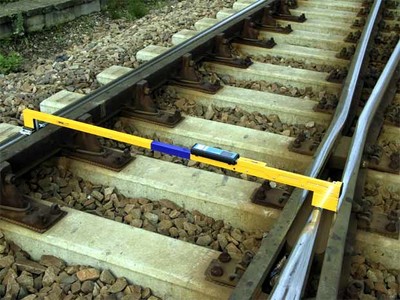From Ox Carts to Railways May 2, 2011
Author: Beach Combing | in : Modern, Prehistoric , trackbackArchaeologists love the idea of continuity, the notion that little really changes, that from generation to generation, though the forms, languages and professions of faith may alter, the substance remains the same.
Historians are, generally speaking, the opposite. They fixate on change and have little patience with the archaeological fraternity – Beachcombing wrote for many years about a period in which historians are the prisoners of archaeologists so he speaks with almost pathological bitterness here.
However, every so often around the fringes of civilisations even hardened sceptics like Beachcombing have to admit that there are remarkable examples of fossils being passed down from generation to generation.
One example that Beachcombing has enjoyed in the last few days has been the measurements of ancient ox carts in Euro-Asia and their relation to modern railway gauges.
Prehistoric ox-carts had gauges of between 1.30 and 1.60 metres with an average of about 1.45 m. In part the physics of cart construction constrained size, but this remarkable consistency over a mere thirty centimetres suggests that there were local, if not continent-wide conventions that were followed.
Certainly even into the industrial age there were strong regional conventions in different corners of Europe.
The great Stuart Piggott (36) – Beachcombing’s kind of archaeologist – recorded speaking to an elderly farmer in the early part of the twentieth century who had moved, in the 1880s, from the south-west of Britain to Lincolnshire and who had been obliged to add about 25 centimetres to his carts’ gauge so that they would fit into the Lincolnshire ruts.
Curiously one of these conventions crossed from prehistoric carts to the railways.
When George Stephenson built the Stockton to Darlington railway in 1825 he adopted the local Durham cart gauge of about 1.42 cm that Parliament then adjusted upwards by a centimetre in 1828.
Most railways around the world today run on that Parliament-dictated gauge of 1.43.5, essentially the tracks of the ancient carts of Europe and near Asia stretching back long before literacy, wine-making, monotheism and other boorish novelties…
Beachcombing simply doesn’t have the background in railways to know whether Stephenson’s choice was an example of an inventor caught in the thrall of tradition – think of the ordering of letters on keyboards.
Or whether, instead, there were good mechanical reasons for conforming.
Would a railway with a 1.90 gauge have made sense in the early nineteenth century? drbeachcombing AT yahoo DOT com
***
19 May 2011: Invisible was first with a comment: ‘Speaking of the spirit of continuity in history, your post on the ox carts reminded me of a conversation I had with the Master Wheelwright John Boag at Colonial Williamsburg. He said that the materials used in the parts of a spoked wheel have been very consistent, tracing back to Celtic times. The hub is made of elm (which has an interlocking grain so it won’t split). The spokes are made of ash. The fellies (curved bits forming the actually wheel) are carved of oak. He had explanations about the properties of these woods which made each of them ideal for their purpose (elm is the only one I remember specifically). So not so much continuity perhaps as perfect utility. I won’t go into the notion that two of the woods are “sacred” woods (and where is the “bitter thorn” in the oak-and-ash lineup?). If you want more information, The Deane Shop, as the wheelwright shop is known, is on Facebook. Here’s a past interview with John Boag.‘ Then came Kate with memories of hols in the Levant: About 20 years ago on a trip to Israel, I noticed the stepping stones across the streets in Old Jerusalem. The most recent upgrade had probably been done by the Romans and the placement of the stones corresponded to the width of chariots and ox carts. The two outside stones for the wider ox carts and the two inner ones for the chariots. I’m sure this placement occurred in other Roman cities. It stayed in my mind, as an example of Roman engineering.’ On this subject there seems to be some modern myths – three emails on this – about Caesar setting the gauge: though of course the measurements predate him… Then, finally, looks like the title should really be from Ox Carts to Space Travel. LouisK writes in: ‘After reading your post on railway gauges, I was reminded of a story I read about the spaceshuttle having some spec constraints because of railway width.’ Thanks Invisible and Kate and Louis.



